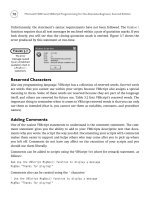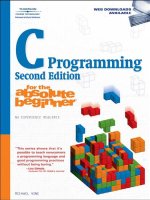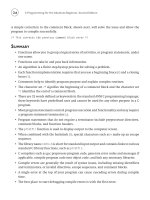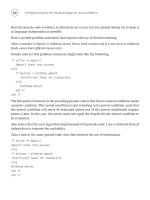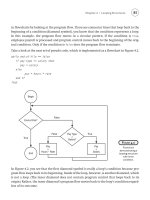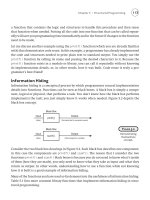C++ Programming for Games Module II phần 10 pps
Bạn đang xem bản rút gọn của tài liệu. Xem và tải ngay bản đầy đủ của tài liệu tại đây (838.76 KB, 42 trang )
267
18.2.1.3 Puck Paddle Collision
When a paddle, be it blue or red, hits the puck, a physically realistic response should follow. Thus, we
must be able to determine how two circular masses (paddle and puck) physically respond when they
collide. The physics of this collision requires a lengthy discussion, so we have given it its own separate
section in Section 18.4. What follows now is an informal conceptual explanation. A more rigorous
explanation is given in Section 18.4.
Before we can even discuss anything about collisions, we need some criterion to determine if the paddle
and puck collided at all. From Figure 18.4 it follows that if the length from
1
c
r
to
2
c
r
is less than or equal
to the sum of the radii then the circles must intersect or touch, which implies a collision. This will be
our criterion for testing whether a collision took place. In pseudocode that is,
Collision Test
if
2112
RRcc +≤−
rr
Intersect = true;
Else
Intersect = false;
Figure 18.4: (a) The circles are not touching or interpenetrating. (b) The circles are tangents (i.e., touching). (c) The
circles are interpenetrating.
Consider Figure 18.5, where two circular masses
1
m and
2
m collide. Intuitively, each object ought to
“feel” an equal and opposite impulse in the direction n
ˆ
r
, which is perpendicular to the collision point.
268
This vector n
ˆ
r
is called the collision normal. Incidentally, n
ˆ
r
can be computed by normalizing the
vector that goes from
1
c
r
to
2
c
r
; that is,
12
12
ˆ
cc
cc
n
rr
rr
r
−
−
=
Figure 18.5: A collision. The impulse vectors lie on the line of the collision normal.
Here we use the word “impulse” very loosely. We give its formal physical definition in Section 18.4.
For now, think of impulse as a vector quantity that changes the velocity (direction or magnitude or both)
of an object in the direction of the impulse. In addition to velocities, the mass of the objects plays a role
in the response. For example, if
2
m is more massive than
1
m we would expect the impulse of the
collision to not effect
2
m as drastically as
1
m . To compensate for the mass, we can divide the impulse
269
vector by the mass of the object. That way, if the object is massive then the impulse vector will be less
influential, and if the object is not so massive then the impulse vector will be more influential. Based on
this discussion, if
nj
ˆ
r
and
nj
ˆ
r
−
are the impulses (remember the impulse vectors are in the direction n
ˆ
r
or opposite of n
ˆ
r
) and if
i
v
1
r
and
i
v
2
r
are the initial velocities of
1
m and
2
m , respectively, before the
collision, then the velocities after the collision should be computed as follows:
(1)
1
11
ˆ
m
nj
vv
if
r
+=
(2)
2
22
ˆ
m
nj
vv
if
r
−=
The reason equation (2) has a negative impulse is because we reasoned each object ought to “feel” an
equal and opposite impulse in the direction n
ˆ
r
, the key word being “opposite”. Also note that j is
actually negative, and we compensate for that by negating the signs; that is why the impulse vectors in
Figure 18.5 may seem backward. But just understand that the negative sign in the j will reverse them.
Let us go over equations (1) and (2) briefly. We said that the impulse would change the direction of the
velocity of an object in the direction of the impulse, which summing the initial velocity with the impulse
vector does (e.g., njv
i
ˆ
2
r
+ ). We also said that the mass of the object should determine how much
influence the impulse vector has to change the initial velocity. We include the mass factor by dividing
the impulse vector by the mass. Thus, if the mass is large then the effect of the impulse vector
diminishes and if the mass is small then the effect of the impulse vector increases. Dividing the impulse
vector by the mass gives us equations (1) and (2).
We still do not know what j is, and therefore we do not know the impulse vector (we just know its
direction n
ˆ
r
and that it has some magnitude j). It turns out that the magnitude of the impulse j is
determined by the relative velocity of
1
m and
2
m , n
ˆ
r
, and the masses, which is not surprising.
By
relative velocity we mean the velocity of mass
1
m relative to mass
2
m ; in other words, how are the
velocities moving with respect to each other? We can compute the velocity of
1
m relative to
2
m like so:
2112
vvv
rrr
−= , where
12
v
r
means the velocity of mass
1
m relative to the velocity of mass
2
m . (Note then
that
1221
vvv
rrr
+= .) For example, consider the two cars in Figure (18.6a).
270
Figure 18.6: Relative velocities.
Car 1 is moving faster than Car 2 and as such, Car 1 will eventually collide with Car 2. However, Car 1
is only going 5 miles per hour faster than Car 2. When Car 1 hits Car 2, will Car 2 feel an 80 miles per
hour “impact?” Common sense tells us this would not be the case. Relative to Car 2, Car 1 is only going
5 miles per hour and so Car 2 will only feel a 5 miles per hour “impact” (
57580
2112
=
−
=
−= vvv
rrr
miles per hour).
Consider Figure (18.6b). Here, Car 2 is stopped, so Car 1 is going 80 miles per hour relative to Car 2.
Consequently, Car 2 will this time feel an 80 miles per hour “impact” (
80080
2112
=
−=−
=
vvv
rr
r
miles
per hour). The point of this discussion is that when talking about two objects colliding, it only makes
sense to talk in relative terms.
We will derive j in Section 18.4, but for now we will accept without proof that,
(3)
(
)
⎟
⎟
⎠
⎞
⎜
⎜
⎝
⎛
+
⋅−
=
21
,12
11
ˆ
2
mm
nv
j
i
r
r
With (3) we can rewrite (1) and (2) as,
271
(4)
(
)
⎟
⎟
⎠
⎞
⎜
⎜
⎝
⎛
+
⋅−
+=
2
1
1
1
,12
11
ˆˆ
2
m
m
m
m
nnv
vv
i
if
r
r
r
(5)
(
)
⎟
⎟
⎠
⎞
⎜
⎜
⎝
⎛
+
⋅−
−=
2
2
1
2
,12
22
ˆˆ
2
m
m
m
m
nnv
vv
i
if
r
r
r
Observe the negative sign that comes out of j, which was mentioned before.
We now know everything we need to solve for
f
v
1
and
f
v
2
; the initial velocities are given, the masses
are given, the relative initial velocity is known, and
n
ˆ
r
can be found via geometric means.
Equations (4) and (5) are pretty general, but we can simplify things by looking at our specific paddle-
puck collision case. Suppose
1
m is the paddle and
2
m is the puck. Because the player holds down the
paddle (either human or AI), we say that the paddle is not influenced by the collision at all (a player can
easily stand his/her ground against a small air hockey puck). Physically, we can view this as the paddle
1
m having a mass of infinity, which makes equation (4) reduce to:
(6)
iif
vvv
111
0 =+=
,
This says that the collision does not change the velocity of the paddle.
Similarly, an infinitely massive paddle causes equation (5) to reduce to:
Collision Response of the Puck
(7)
(
)
nnvvv
iif
ˆˆ
2
,1222
r
r
r
⋅+=
Equation (7) is really the only equation we will need in our implementation. This equation will be used
to compute the new velocity of the puck after it collides with a paddle.
Incidentally, if
0
ˆ
,12
<⋅ nv
i
r
r
, it means that the objects
1
m and
2
m are actually already moving away from
each other, which means no collision response is necessary.
272
18.2.1.4 Puck Wall Collision
We need to determine how an immovable line (2D wall) and a circle (the puck) physically respond when
they collide. Simple real world observation tells us that if an air hockey puck is traveling with a velocity
I
r
(we call
I
r
the incident vector) and hits a wall, then it will reflect and have a new velocity
R
r
—see
Figure 18.7 (we approximate a zero speed loss from the bounce which is only approximately true).
Observe that the reflection vector
R
r
has the same magnitude as the incident vector
I
r
; the only
difference is the direction is reflected. So our task at hand is, given the incoming velocity
I
r
, to compute
the reflected velocity
R
r
. To do this, let us again examine Figure 18.7.
Figure 18.7: When a puck hits an edge it reflects. We assume the puck does not lose speed during the collision.
Figure 18.7 shows four cases that correspond to the four edges off of which the puck can bounce. When
the puck bounces off the left or right edge, we notice that the difference between
I
r
and
R
r
is simply that
that the vector x-components are opposite. Therefore, to reflect off the left or right edge we just negate
the x-component of
I
r
to get
R
r
. Similarly, when the puck bounces off the top or bottom edge, we
notice that the difference between
I
r
and
R
r
is simply that the vector y-components are opposite.
Therefore, to reflect off the top or bottom edge we just negate the y-component of
I
r
to get
R
r
.
If (x, y) is the puck center point and r its radius, then we have the following puck/wall collision
algorithm:
// Reflect velocity off left edge (if we hit the left edge).
if( x - r < left )
mPuck->mVelocity.x *= -1.0f;
273
// Reflect velocity off right edge (if we hit the right edge).
if(x + r > right )
mPuck->mVelocity.x *= -1.0f;
// Reflect velocity off top edge (if we hit the top edge).
if(y - r < top )
mPuck->mVelocity.y *= -1.0f;
// Reflect velocity off bottom edge (if we hit the bottom edge).
if(y + r > bottom )
mPuck->mVelocity.y *= -1.0f;
18.2.1.5 Paddle Wall Collision
If a player (human or computer) attempts to move the paddle out-of-bounds, we must override that
action and force the paddle to stay inbounds. To solve this problem we will define a rectangle that
surrounds each player’s side—see Figure 18.8.
Figure 18.8: The rectangles marking the blue “side” and red “side.”
If the paddle goes outside the rectangle, we will simply force it back in. A circle with radius r and
center point (x, y) (modeling a paddle) is outside a rectangle R = {left, top, right, bottom} if the
following compound logical statement is true:
leftrx <− || rightrx >+ || top
r
y
<
−
|| bottomry >
+
274
Again, we are using Windows coordinates where +y goes “down.” Essentially, the above condition asks
if the circle crosses any of the rectangle edges. For example, if leftrx
<
−
is true then it means part (or
all) of the circle is outside the left edge—see Figure 18.9.
Figure 18.9: Criteria for determining if a circle crosses an edge boundary.
We can force a circle back inside the rectangle by adjusting the circle’s center point based on the
rectangle edge that was crossed. For instance, from Figure 18.9 it follows that the smallest x-coordinate
a circle can have while still being inside the rectangle is
R.left + r. So if the circle crosses the left
edge of the rectangle we modify the circle’s center x-coordinate to be
R.left + r:
// Did the circle cross the rectangle’s left edge?
if(p.x - r < R.left)
p.x = R.left + r; // Yes, so modify center
The test and modification for the other edges is analogous:
// Did the circle cross the rectangle’s right edge?
if(p.x + r > R.right)
p.x = R.right - r; // Yes, so modify center
// Did the circle cross the rectangle’s top edge?
if(p.y - r < R.top)
p.y = R.top + r; // Yes, so modify center
// Did the circle cross the rectangle’s bottom edge?
if(p.y + r > R.bottom)
p.y = R.bottom - r; // Yes, so modify center
275
18.2.1.6 Pausing/Unpausing
When the player pauses the game, we must be able to stop all game activity, and when the player
unpauses the game we must be able to resume all game activity from the point preceding the pause.
This might seem like a difficult problem at first glance, but it turns out to be extremely simple to handle.
We keep a Boolean variable
paused, which is true if the game is paused and false otherwise. Then,
when we go to update the game we can do a quick check:
If( not paused )
UpdateGame
Else
DoNotUpdateGame
In this way, if the game is paused, then we do not update the game. If the game is not paused, then we
do update the game.
18.2.1.7 Detecting a Score
We must be able to detect when a point (center of the puck) intersects a goal box (modeled as a
rectangle). This problem is similar to Section 18.2.1.5, but instead of wanting to detect when a circle
goes outside a rectangle, we want to detect when a point goes inside a rectangle. (We could detect when
a circle—the puck—goes inside a rectangle, but just using the point gives a good approximation for
detecting a score.) A point (x, y) (the center of the puck) is inside a rectangle (goal box) R = {left, top,
right, bottom} if and only if the following logical expression is true:
leftx >=
&&
rightx <=
&& topy >= &&
bottomy
<
=
This implies:
•
leftx >= : x is to the right of the left edge or lies on the left edge.
•
rightx <= : x is to the left of the right edge or lies on the right edge.
•
topy >=
: y is below the top edge or lies on the top edge.
•
bottomy <= : y is above the bottom edge or lies on the bottom edge.
If all four of these conditions are true then we can conclude that the point is inside the rectangle or lies
on the edge of a rectangle, which for our purposes we consider to be inside. Again, everything is in
Windows coordinates.
276
18.2.2 Software Design
From the previous chapter, we already know how we are going to handle the graphics of the game. We
will use double buffering and timers to provide smooth animation, and we will use sprites to draw the
background game board, the paddles, and the puck.
For the paddle-puck collision detection, we will need to determine if a paddle hits the puck. Since both
the paddle and puck are circular, it is natural to model these objects’ areas with a circle. Thus, we shall
create a
Circle class as follows:
#ifndef CIRCLE_H
#define CIRCLE_H
#include "Vec2.h"
class Circle
{
public:
Circle();
Circle(float R, const Vec2& center);
bool hits(Circle& A, Vec2& normal);
float r; // radius
Vec2 c; // center point
};
#endif // CIRCLE_H
The only method this class contains other than the two constructors is the
hits method. This method
returns
true if the circle object invoking the method hits (or intersects) the circle passed in as a
parameter
A, otherwise it returns false. If the two circles do hit each other then the method also
returns the collision normal via the reference parameter
normal.
In addition to circles, many of the Air Hockey game elements are rectangular; specifically, the game
board, the player side regions, and the goal box. To facilitate representation of these elements we define
a
Rect class:
#ifndef RECT_H
#define RECT_H
#include "Circle.h"
class Rect
{
public:
Rect();
Rect(const Vec2& a, const Vec2& b);
Rect(float x0, float y0, float x1, float y1);
void forceInside(Circle& A);
277
bool isPtInside(const Vec2& pt);
Vec2 minPt;
Vec2 maxPt;
};
#endif // RECT_H
You might suggest that we just use the Win32
RECT structure. This would work. However, we want to
add some new methods, so we might as well implement our own. Moreover, we want to use
Vec2
objects for points, as their components are floating-point, whereas the coordinates of
RECT are integers.
With
RECT we used coordinates left, top, right, bottom to define a rectangle. But if we think about it,
the point (left, top) defines the minimum point of the rectangle and the point (right, bottom) defines the
maximum point of the rectangle (note we are using Windows coordinates where +y goes “down”). So
instead of using left, top, right, bottom data members, we just use a
minPt (for the minimum point) and
maxPt (for the maximum point).
1.
void forceInside(Circle& A);
This method forces the
Circle A to be inside the Rect object that invokes this method. This
method implements the algorithm discussed in Section 18.2.1.5 for keeping the paddle inside its
boundary rectangle.
2.
bool isPtInside(const Vec2& pt);
This method returns
true if the point (represented as a vector) pt is inside the Rect object that
invokes this method, otherwise the method returns
false. This method implements the
algorithm discussed in Section 18.2.1.7 for detecting when the puck’s center point is inside the
goal box rectangle.
In an effort to organize the Air Hockey program code, we have decided to encapsulate the code specific
to the Air Hockey game in a separate class called
AirHockeyGame. In this way, the Windows specific
code such as window creation, the window procedure, and the message loop, will be separated from the
game code (i.e., in separate files). This makes the implementation cleaner and more structured. In large
projects, organization is significant, if you want to avoid getting lost in complexity. The
AirHockeyGame class is defined like so:
#ifndef AIR_HOCKEY_GAME_H
#define AIR_HOCKEY_GAME_H
#include <windows.h>
#include "Sprite.h"
#include "Rect.h"
#include "Circle.h"
class AirHockeyGame
{
public:
278
AirHockeyGame(HINSTANCE hAppInst, HWND hMainWnd,
Vec2 wndCenterPt);
~AirHockeyGame();
void pause();
void unpause();
void update(float dt);
void draw(HDC hBackBufferDC, HDC hSpriteDC);
private:
void updateBluePaddle(float dt);
void updateRedPaddle(float dt);
void updatePuck(float dt);
bool paddlePuckCollision(Sprite* paddle);
void increaseScore(bool blue);
private:
HINSTANCE mhAppInst;
HWND mhMainWnd;
Vec2 mWndCenterPt;
int mBlueScore;
int mRedScore;
bool mPaused;
const float MAX_PUCK_SPEED;
const float RED_SPEED;
float mRedRecoverTime;
Sprite* mGameBoard;
Sprite* mBluePaddle;
Sprite* mRedPaddle;
Sprite* mPuck;
POINT mLastMousePos;
POINT mCurrMousePos;
Rect mBlueBounds;
Rect mRedBounds;
Rect mBoardBounds;
Rect mBlueGoal;
Rect mRedGoal;
};
#endif // AIR_HOCKEY_GAME_H
We begin by examining the data members.
1.
mhAppInst: A handle to the application instance.
2.
mhMainWnd: A handle to the main window.
3.
mWndCenterPt: Specifies the center point of the window’s client area.
4.
mBlueScore: Integer to keep track of how many points blue has scored.
279
5.
mRedScore: Integer to keep track of how many points red has scored.
6.
mPaused: A Boolean value that is true if the game is currently paused, and false otherwise.
7.
MAX_PUCK_SPEED: A constant that specifies the maximum speed the puck can move.
8.
RED_SPEED: A constant that specifies the speed at which the red (AI) player moves the paddle.
9.
mRedRecoverTime: Used to implement the recovery time idea as discussed in Section 18.2.1.2.
That is, this value stores the remaining time before the red paddle can move again.
10.
mGameBoard: The sprite that represents the game board graphic.
11.
mBluePaddle: The sprite that represents the blue paddle graphic.
12.
mRedPaddle: The sprite that represents the red paddle graphic.
13.
mPuck: The sprite that represents the puck graphic.
14.
mLastMousePos: Used to store the mouse cursor position from the previous frame.
15.
mCurrMousePos: Used to store the mouse cursor of the current frame.
16.
mBlueBounds: A rectangle describing the blue side.
17.
mRedBounds: a rectangle describing the red side.
18.
mBoardBounds: A rectangle describing the entire game board; that is, blue’s side and red’s side.
19.
mBlueGoal: A rectangle describing the blue side goal box.
20.
mRedGoal: A rectangle describing the red side goal box.
We now turn attention to the methods:
1.
void pause();
This method is used to pause the game.
2.
void unpause();
This method is used to unpause the game.
3.
void update(float dt);
This method updates all of the game objects; essentially it calls all of the private “helper” update
methods.
4.
void draw(HDC hBackBufferDC, HDC hSpriteDC);
This method draws all the sprites to the backbuffer, and it also draws the current red and blue
scores to the backbuffer.
5. void updateBluePaddle(float dt);
This method updates the blue paddle’s position after dt seconds have passed. It computes the
current mouse velocity as Section 18.2.1.1 describes, and updates the position accordingly. In
addition, it also ensures that the blue paddle stays inbounds (18.2.1.5).
280
6.
void updateRedPaddle(float dt);
This method updates the red paddle’s position after
dt seconds have passed using the AI
algorithm as described in Section 18.2.1.1. In addition, it also ensures that the red paddle stays
inbounds (18.2.1.5).
7. void updatePuck(float dt);
This method updates the puck’s position after dt seconds have passed. It computes the reflected
velocity if the puck hits a wall (18.2.1.4). It also detects paddle-puck collisions, and if there is a
collision then it computes the new velocity of the puck after the collision (18.2.1.3). In addition
to making sure the puck stays within the game board boundaries, it also checks to see if the
puck’s center made it into one of the goal boxes (18.2.1.7); i.e., did a player score a goal?
8. bool paddlePuckCollision(Sprite* paddle);
This method is called internally by updatePuck. This method actually performs the
mathematical calculations of the paddle-puck collision (18.2.1.3). Note that this function takes a
pointer to the sprite representing the paddle as a parameter. In this way, the function can be
called for either the blue or red paddle.
9. void increaseScore(bool blue);
This method simply increases the score of the blue player if blue is true, otherwise it increases
the score of the red player. Furthermore, after increasing the score this method resets the puck to
the middle of the game board.
18.3 Implementation
With our design work accomplished in the preceding section, the implementation stage is relatively
straightforward.
18.3.1 Circle
The implementation to the circle class is as follows:
#include "Circle.h"
Circle::Circle()
: r(0.0f), c(0.0f, 0.0f)
{
}
281
Circle::Circle(float R, const Vec2& center)
: r(R), c(center)
{
}
bool Circle::hits(Circle& A, Vec2& normal)
{
Vec2 u = A.c - c;
if( u.length() <= r + A.r )
{
normal = u.normalize();
// Make sure circles never overlap at most
// they can be tangent.
A.c = c + (normal * (r + A.r));
return true;
}
return false;
}
Most of this is clear; the “hit” criterion comes straight from Section 18.2.1.3 from the “Collision Test”
box. One interesting thing we do, however, is if the circles are interpenetrating then we adjust the center
of
A so that they are no longer interpenetrating. The circles can become interpenetrating in code since
our position updates occur in discrete steps; however, this should never happen physically. Therefore,
as soon as we encounter interpenetrating circles, we modify the center of
A to make them tangent (i.e.,
touching).
18.3.2 Rect
Likewise, the Rect class implementation is straightforward as well:
#include "Rect.h"
Rect::Rect()
{
}
Rect::Rect(const Vec2& a, const Vec2& b)
: minPt(a), maxPt(b)
{
}
Rect::Rect(float x0, float y0, float x1, float y1)
: minPt(x0, y0), maxPt(x1, y1)
{
}
void Rect::forceInside(Circle& A)
{
282
Vec2 p = A.c;
float r = A.r;
// Modify coordinates to force inside.
if(p.x - r < minPt.x)
p.x = minPt.x + r;
if(p.x + r > maxPt.x)
p.x = maxPt.x - r;
if(p.y - r < minPt.y)
p.y = minPt.y + r;
if(p.y + r > maxPt.y)
p.y = maxPt.y - r;
// Save forced position.
A.c = p;
}
bool Rect::isPtInside(const Vec2& pt)
{
return pt.x >= minPt.x && pt.y >= minPt.y &&
pt.x <= maxPt.x && pt.y <= maxPt.y;
}
The implementation of
forceInside comes straight from the work done in Section 18.2.1.5, and the
implementation of
isPtInside comes straight from the work done in Section 18.2.1.7.
18.3.3 AirHockeyGame
We now present the implementation to the AirHockeyGame class. The implementation comes directly
from our design discussion in Section 18.2. For the most part, there are no new concepts here and
therefore we will just present the code. However, Figure 18.10 may help in understanding where the
game rectangle coordinates came from.
283
Figure 18.10: The coordinates of the various game rectangles defined.
#include "AirHockeyGame.h"
#include <cstdio>
#include "resource.h" // For Bitmap resource IDs
AirHockeyGame::AirHockeyGame(HINSTANCE hAppInst,
HWND hMainWnd,
Vec2 wndCenterPt)
: MAX_PUCK_SPEED(1000.0f), RED_SPEED(300.0f)
{
// Save input parameters.
mhAppInst = hAppInst;
mhMainWnd = hMainWnd;
mWndCenterPt = wndCenterPt;
// Players start game with score of zero.
mBlueScore = 0;
mRedScore = 0;
// The game is initially paused.
mPaused = true;
// No recovery time for red to start.
mRedRecoverTime = 0.0f;
// Create the sprites:
Circle bc;
Vec2 p0 = wndCenterPt;
Vec2 v0(0.0f, 0.0f);
284
mGameBoard = new Sprite(mhAppInst, IDB_GAMEBOARD,
IDB_GAMEBOARD_MASK, bc, p0, v0);
bc.c = p0;
bc.r = 18.0f; // Puck radius = 18
mPuck = new Sprite(mhAppInst, IDB_PUCK,
IDB_PUCK_MASK, bc, p0, v0);
p0.x = 700;
p0.y = 200;
bc.c = p0;
bc.r = 25.0f; // Paddle radius = 25
mRedPaddle = new Sprite(mhAppInst, IDB_REDPADDLE,
IDB_PADDLE_MASK, bc, p0, v0);
p0.x = 100;
p0.y = 100;
bc.c = p0;
bc.r = 25.0f; // Paddle radius = 25
mBluePaddle = new Sprite(mhAppInst, IDB_BLUEPADDLE,
IDB_PADDLE_MASK, bc, p0, v0);
// Initialize the rectangles.
mBlueBounds = Rect(7, 40, 432, 463);
mRedBounds = Rect(432, 40, 854, 463);
mBoardBounds = Rect(7, 40, 854, 463);
mBlueGoal = Rect(0, 146, 25, 354);
mRedGoal = Rect(838, 146, 863, 354);
}
AirHockeyGame::~AirHockeyGame()
{
delete mGameBoard;
delete mBluePaddle;
delete mRedPaddle;
delete mPuck;
}
void AirHockeyGame::pause()
{
mPaused = true;
// Game is unpaused release capture on mouse.
ReleaseCapture();
// Show the mouse cursor when paused.
ShowCursor(true);
}
void AirHockeyGame::unpause()
{
// Fix cursor to paddle position.
POINT p = mBluePaddle->mPosition;
ClientToScreen(mhMainWnd, &p);
285
SetCursorPos(p.x, p.y);
GetCursorPos(&mLastMousePos);
mPaused = false;
// Capture the mouse when not paused.
SetCapture(mhMainWnd);
// Hide the mouse cursor when not paused.
ShowCursor(false);
}
void AirHockeyGame::update(float dt)
{
// Only update the game if the game is not paused.
if( !mPaused )
{
updateBluePaddle(dt);
updateRedPaddle(dt);
updatePuck(dt);
// Decrease recovery time as time passes.
if( mRedRecoverTime > 0.0f )
mRedRecoverTime -= dt;
}
}
void AirHockeyGame::draw(HDC hBackBufferDC, HDC hSpriteDC)
{
// Draw the sprites.
mGameBoard->draw(hBackBufferDC, hSpriteDC);
mBluePaddle->draw(hBackBufferDC, hSpriteDC);
mRedPaddle->draw(hBackBufferDC, hSpriteDC);
mPuck->draw(hBackBufferDC, hSpriteDC);
// Draw the player scores.
char score[32];
sprintf(score, "Blue's score = %d", mBlueScore);
SetBkMode(hBackBufferDC, TRANSPARENT);
TextOut(hBackBufferDC, 15, 45, score, (int)strlen(score));
sprintf(score, "Red's score = %d", mRedScore);
TextOut(hBackBufferDC, 740, 45, score, (int)strlen(score));
}
void AirHockeyGame::updateBluePaddle(float dt)
{
GetCursorPos(&mCurrMousePos);
// Change in mouse position.
int dx = mCurrMousePos.x - mLastMousePos.x;
int dy = mCurrMousePos.y - mLastMousePos.y;
Vec2 dp((float)dx, (float)dy);
286
// Velocity is change in position with respect to time.
mBluePaddle->mVelocity = dp / dt;
// Update the blue paddle's position.
mBluePaddle->update(dt);
// Make sure the blue paddle stays inbounds.
mBlueBounds.forceInside(mBluePaddle->mBoundingCircle);
mBluePaddle->mPosition = mBluePaddle->mBoundingCircle.c;
// The current position is now the last mouse position.
mLastMousePos = mBluePaddle->mPosition;
// Keep mouse cursor fixed to paddle.
ClientToScreen(mhMainWnd, &mLastMousePos);
SetCursorPos(mLastMousePos.x, mLastMousePos.y);
}
void AirHockeyGame::updateRedPaddle(float dt)
{
// The red paddle's AI is overly simplistic: When the
// puck moves into red's boundary, the red paddle
// simply moves directly towards the puck to hit it.
// When the puck leaves red's boundaries, the red
// paddle returns to the center of its boundary.
if( mRedRecoverTime <= 0.0f )
{
// Is the puck in red's boundary? If yes, then
// move the red paddle directly toward the puck.
if( mRedBounds.isPtInside(mPuck->mPosition) )
{
// Vector directed from paddle to puck.
Vec2 redVel = mPuck->mPosition - mRedPaddle->mPosition;
redVel.normalize();
redVel *= RED_SPEED;
mRedPaddle->mVelocity = redVel;
}
// If no, then move the red paddle to the point (700, 200).
else
{
Vec2 redVel = Vec2(700, 200) - mRedPaddle->mPosition;
if(redVel.length() > 5.0f)
{
redVel.normalize();
redVel *= RED_SPEED;
mRedPaddle->mVelocity = redVel;
}
// Within 5 units close enough.
else
mRedPaddle->mVelocity = Vec2(0.0f, 0.0f);
}
// Update the red paddle's position.
mRedPaddle->update(dt);
287
// Make sure the red paddle stays inbounds.
mRedBounds.forceInside(mRedPaddle->mBoundingCircle);
mRedPaddle->mPosition = mRedPaddle->mBoundingCircle.c;
}
}
void AirHockeyGame::updatePuck(float dt)
{
paddlePuckCollision(mBluePaddle);
// If red hits the puck then make a small 1/10th of a second
// delay before the red paddle can move away as sort of a
// "recovery period" after the hit. This is to model the
// fact that when a human player hits something, it takes
// a short period of time to recover from the collision.
if(paddlePuckCollision(mRedPaddle))
mRedRecoverTime = 0.1f;
// Clamp puck speed to some maximum velocity; this provides
// good stability.
if( mPuck->mVelocity.length() >= MAX_PUCK_SPEED )
mPuck->mVelocity.normalize() *= MAX_PUCK_SPEED;
// Did the puck hit a wall? If so, reflect about edge.
Circle puckCircle = mPuck->mBoundingCircle;
if( puckCircle.c.x - puckCircle.r < mBoardBounds.minPt.x )
mPuck->mVelocity.x *= -1.0f;
if( puckCircle.c.x + puckCircle.r > mBoardBounds.maxPt.x )
mPuck->mVelocity.x *= -1.0f;
if( puckCircle.c.y - puckCircle.r < mBoardBounds.minPt.y )
mPuck->mVelocity.y *= -1.0f;
if( puckCircle.c.y + puckCircle.r > mBoardBounds.maxPt.y )
mPuck->mVelocity.y *= -1.0f;
// Make sure puck stays inbounds of the gameboard.
mBoardBounds.forceInside(mPuck->mBoundingCircle);
mPuck->mPosition = mPuck->mBoundingCircle.c;
mPuck->update(dt);
if( mBlueGoal.isPtInside(mPuck->mPosition) )
increaseScore(false);
if( mRedGoal.isPtInside(mPuck->mPosition) )
increaseScore(true);
}
bool AirHockeyGame::paddlePuckCollision(Sprite* paddle)
{
Vec2 normal;
if(paddle->mBoundingCircle.hits(mPuck->mBoundingCircle, normal))
{
// Hit updates cirle's position. So update pucks
// position as well since the two correspond.
mPuck->mPosition = mPuck->mBoundingCircle.c;
//*******************
288
// Apply equation (7)
//*******************
// Compute the paddle's velocity relative to the puck's
// velocity.
Vec2 relVel = paddle->mVelocity - mPuck->mVelocity;
// Get the component of the relative velocity along
// the normal.
float impulseMag = relVel.dot(normal);
// Are the objects getting closer together?
if( impulseMag >= 0.0f )
{
// Project the relative velocity onto the normal.
Vec2 impulse = impulseMag * normal;
// Add the impulse to the puck.
mPuck->mVelocity += 2.0f * impulse;
return true;
}
}
return false;
}
void AirHockeyGame::increaseScore(bool blue)
{
if( blue )
++mBlueScore;
else
++mRedScore;
// A point was just scored, so reset puck to center and
// pause game.
mPuck->mPosition = Vec2(mWndCenterPt.x, mWndCenterPt.y);
mPuck->mVelocity = Vec2(0.0f, 0.0f);
mPuck->mBoundingCircle.c = Vec2(mWndCenterPt.x, mWndCenterPt.y);
// After score, pause the game so player can prepare for
// next round.
pause();
}
18.3.4 Main Application Code
Finally, we show the main application code, which creates the window, implements the window
procedure, and enters the message loop. We have seen most of this code before.
// giAirHockey.cpp
// By Frank Luna
// August 24, 2004.
289
//=========================================================
// Includes
//=========================================================
#include <string>
#include "resource.h"
#include "AirHockeyGame.h"
#include "BackBuffer.h"
using namespace std;
//=========================================================
// Globals
//=========================================================
HWND ghMainWnd = 0;
HINSTANCE ghAppInst = 0;
HMENU ghMainMenu = 0;
HDC ghSpriteDC = 0;
BackBuffer* gBackBuffer = 0;
AirHockeyGame* gAirHockey = 0;
string gWndCaption = "Game Institute Air Hockey";
// Client dimensions exactly equal dimensions of
// background bitmap. This is found by inspecting
// the bitmap in an image editor, for example.
const int gClientWidth = 864;
const int gClientHeight = 504;
// Center point of client rectangle.
const POINT gClientCenter =
{
gClientWidth / 2,
gClientHeight / 2
};
// Pad window dimensions so that there is room for window
// borders, caption bar, and menu.
const int gWindowWidth = gClientWidth + 6;
const int gWindowHeight = gClientHeight + 52;
//=========================================================
// Function Prototypes
//=========================================================
bool InitMainWindow();
int Run();
void DrawFramesPerSecond(float deltaTime);
LRESULT CALLBACK
WndProc(HWND hWnd, UINT msg, WPARAM wParam, LPARAM lParam);
BOOL CALLBACK
AboutBoxProc(HWND hDlg, UINT msg, WPARAM wParam, LPARAM lParam);
290
//=========================================================
// Name: WinMain
// Desc: Program execution starts here.
//=========================================================
int WINAPI
WinMain(HINSTANCE hInstance, HINSTANCE hPrevInstance,
PSTR cmdLine, int showCmd)
{
ghAppInst = hInstance;
// Create the main window.
if( !InitMainWindow() )
{
MessageBox(0, "Window Creation Failed.", "Error", MB_OK);
return 0;
}
// Enter the message loop.
return Run();
}
//=========================================================
// Name: InitMainWindow
// Desc: Creates main window for drawing game graphics
//=========================================================
bool InitMainWindow()
{
WNDCLASS wc;
wc.style = CS_HREDRAW | CS_VREDRAW;
wc.lpfnWndProc = WndProc;
wc.cbClsExtra = 0;
wc.cbWndExtra = 0;
wc.hInstance = ghAppInst;
wc.hIcon = ::LoadIcon(0, IDI_APPLICATION);
wc.hCursor = ::LoadCursor(0, IDC_ARROW);
wc.hbrBackground = (HBRUSH)::GetStockObject(NULL_BRUSH);
wc.lpszMenuName = 0;
wc.lpszClassName = "MyWndClassName";
RegisterClass( &wc );
// WS_OVERLAPPED | WS_SYSMENU: Window cannot be resized
// and does not have a min/max button.
ghMainMenu = LoadMenu(ghAppInst, MAKEINTRESOURCE(IDR_MENU));
ghMainWnd = ::CreateWindow("MyWndClassName",
gWndCaption.c_str(), WS_OVERLAPPED | WS_SYSMENU,
200, 200, gWindowWidth, gWindowHeight, 0,
ghMainMenu, ghAppInst, 0);
if(ghMainWnd == 0){
::MessageBox(0, "CreateWindow - Failed", 0, 0);
return 0;
}
ShowWindow(ghMainWnd, SW_NORMAL);
UpdateWindow(ghMainWnd);
return true;
}
291
//=========================================================
// Name: Run
// Desc: Encapsulates the message loop.
//=========================================================
int Run()
{
MSG msg;
ZeroMemory(&msg, sizeof(MSG));
// Get the current time.
float lastTime = (float)timeGetTime();
float timeElapsed = 0.0f;
while(msg.message != WM_QUIT)
{
// IF there is a Windows message then process it.
if(PeekMessage(&msg, 0, 0, 0, PM_REMOVE))
{
TranslateMessage(&msg);
DispatchMessage(&msg);
}
// ELSE, do game stuff.
else
{
// Get the time now.
float currTime = (float)timeGetTime();
// Compute the differences in time from the last
// time we checked. Since the last time we checked
// was the previous loop iteration, this difference
// gives us the time between loop iterations
// or, I.e., the time between frames.
float deltaTime = max((currTime - lastTime)*0.001f, 0.0f);
timeElapsed += deltaTime;
// Only update once every 1/100 seconds.
if( timeElapsed >= 0.01 )
{
// Update the game and draw everything.
gAirHockey->update((float)timeElapsed);
// Draw every frame.
gAirHockey->draw(gBackBuffer->getDC(),
ghSpriteDC);
DrawFramesPerSecond(timeElapsed);
// Now present the backbuffer contents to
// the main window client area.
gBackBuffer->present();
timeElapsed = 0.0;
}
// We are at the end of the loop iteration, so
// prepare for the next loop iteration by making



